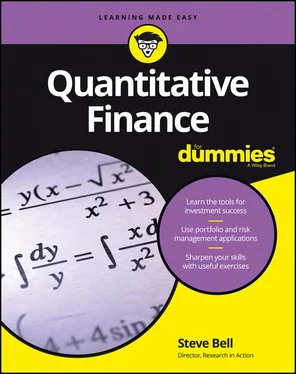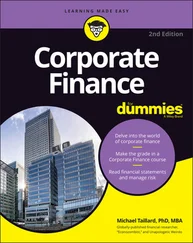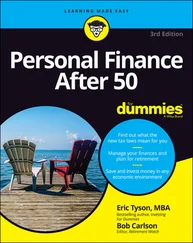 Always choose the simplest model possible that describes your data. Chapter 17shows you in more depth how to fit models in these situations and statistics you can use to determine whether you have a good model or not.
Always choose the simplest model possible that describes your data. Chapter 17shows you in more depth how to fit models in these situations and statistics you can use to determine whether you have a good model or not.
Looking at the finer details of markets
In Chapter 18, you can find out more about markets in real life. Some of this information isn’t pretty, but it is important. One important mechanism is market impact, the amount by which prices move when you buy or sell an asset. In a way, this impact is the reason markets are important – prices change with supply and demand. The example using Bayes’ theorem shows how markets can take on new information and reflect it in changed prices. Doing so is the way that markets can become almost efficient.
Trading at higher frequency
More and more financial trading is completely automated. Computers running powerful algorithms buy and sell stocks and futures contracts often with holding periods of less than a second – sometimes less than a millisecond. This high frequency trading (HFT) must use maths and algorithms. It is part of quantitative finance and many quants are involved with the development of trading algorithms.
Chapter 2
Understanding Probability and Statistics
IN THIS CHAPTER
Comprehending that events can be random
Gathering data to produce statistics of random variables
Defining some important distributions
If you’ve ever placed a bet on a horse or wondered whether your date for the evening is going to turn up, then you know a bit about probability and statistics. The concepts get more interesting if you have multiple events or events in succession.
For example, if you manage to pick both the first and second place horses in a race (an exacta ) does that mean you have real skill? This common bet offered by bookies is almost as creative as some of the speculative products offered by bankers.
In this chapter, I start with a few ideas about probability and continue by showing you how they apply to statistical distributions. I examine applications of probability, starting with dice games.
I then look at what happens when you have many random events and a distribution of outcomes.
One distribution of special importance is the Gaussian distribution. It keeps on appearing, and I introduce you to its key properties. I also introduce you to the law of large numbers, which is a more mathematical way of looking at the outcome of a large number of random events.
Probability boils down to a number that refers to a specific situation or event. Statistics, on the other hand, is a way of reasoning from large amounts of data back to some general conclusion – a tool for dealing with data. The later sections of this chapter take you through some widely used results that help in understanding data sets.
The situations I present in this chapter come to look like financial markets, where day-by-day or even millisecond-by-millisecond prices are changing in a highly volatile fashion. So, this chapter gives you a taste of some of the key quantitative tools for understanding how modern financial markets work.
Figuring Probability by Flipping a Coin
Humans have a deep fascination for outcomes that are not certain. That may be because humans learned early that outcomes in many situations are indeed uncertain. Dice games are the most common method used to examine probability , which is the chance of an event taking place or a statement being true. Dice games have engaged the interest of many famous mathematicians, and because the games are played for money, studying them can be considered the birth of quantitative finance.
Archaeological evidence shows that games of chance have been played for at least the past 34 centuries. Later (well, much later in fact, only several hundred years ago) mathematicians tried to understand the results of these games of chance and that is what led to what is now called probability theory , the mathematical study of randomness.
Probability is the mathematician’s way of analysing random events. To define random isn’t so easy and part of what makes the study of randomness important. The rising of the sun tomorrow isn’t a random event but what mathematicians (and almost everyone else) define as certain . Every certain event has a probability of one. An impossible event (such as having hot sunshine every day throughout the summer in England) has a probability of zero. However, whether it will be raining tomorrow or not is a random event with a probability somewhere between one and zero. That doesn’t mean you have no knowledge of whether it will rain, just that even if you have looked at the most reliable forecasts, you still cannot be certain one way or the other. Equally, the flip of a coin is a random event and so is the throw of a die. The outcomes cannot be predicted, at least if the coin or die isn’t loaded in some way.
Philosophers and mathematicians (for example, the French mathematician Laplace) have thought deeply about near-certain events such as the rising of the sun tomorrow. There’s no day on record when the sun didn’t rise, and the probability of the sun rising tomorrow is very, very close to 1, but that isn’t proof that it will continue to rise every day. I’m not trying to be apocalyptic; I’m just using facts to come to conclusions.
 It’s good to be wary of statements about the certainty of something happening or not happening. That can be especially true in finance where it’s easy to take some things for granted. Governments and banks can go bankrupt and stock markets do crash; the probability is very small but not zero.
It’s good to be wary of statements about the certainty of something happening or not happening. That can be especially true in finance where it’s easy to take some things for granted. Governments and banks can go bankrupt and stock markets do crash; the probability is very small but not zero.
Mathematicians tend to evaluate the probability of a symmetrical coin turning up heads using their usual logic. It seems reasonable to assume that the likelihood of the coin turning up heads is the same as that of its turning up tails.
The probability of tossing a head, written as P(H), and the probability of tossing a tail, P(T), is P(H) + P(T) = 1. This is because the only result from tossing a coin is either heads or tails. (If you can flip a coin and make it land on its edge, please ask the publisher of this book for a refund!) Therefore, simple arithmetic shows that the probability of tossing a head is 1/2. However, you can never be sure that the coin is, in fact, symmetric. The experiment of flipping the coin can give you the estimate of the probability. Flip the coin lots and lots of times and count how many times it turns up heads. Divide this by the number of throws, and you get the estimate of the probability of getting heads. Because the number of throws is greater than the number of heads, the estimate is a number between zero and one. This number will converge to 0.5 as long as the number of flips keeps increasing. This is an empirical fact!
 To apply mathematics to the real world, you must make a few assumptions, so you need to be clear what these assumptions are. In this case, ignoring the possibility of a coin landing on its edge is a good one.
To apply mathematics to the real world, you must make a few assumptions, so you need to be clear what these assumptions are. In this case, ignoring the possibility of a coin landing on its edge is a good one.
The sum of the probability of all possible events is one as you can be certain that one of the possibilities will happen.
A similar analysis can be applied to a fair die: There’s a 1/6 probability of throwing any one of the six faces. Here again you have to put on your mathematician’s hat. If the die is fair, the likelihoods of getting 1, 2, 3, 4, 5, or 6 are the same. So, P(i) = 1/6 where i can be any integer from one to six. Now, adding up the probabilities of each way the die can land:
Читать дальше

 Always choose the simplest model possible that describes your data. Chapter 17shows you in more depth how to fit models in these situations and statistics you can use to determine whether you have a good model or not.
Always choose the simplest model possible that describes your data. Chapter 17shows you in more depth how to fit models in these situations and statistics you can use to determine whether you have a good model or not. It’s good to be wary of statements about the certainty of something happening or not happening. That can be especially true in finance where it’s easy to take some things for granted. Governments and banks can go bankrupt and stock markets do crash; the probability is very small but not zero.
It’s good to be wary of statements about the certainty of something happening or not happening. That can be especially true in finance where it’s easy to take some things for granted. Governments and banks can go bankrupt and stock markets do crash; the probability is very small but not zero. To apply mathematics to the real world, you must make a few assumptions, so you need to be clear what these assumptions are. In this case, ignoring the possibility of a coin landing on its edge is a good one.
To apply mathematics to the real world, you must make a few assumptions, so you need to be clear what these assumptions are. In this case, ignoring the possibility of a coin landing on its edge is a good one.










